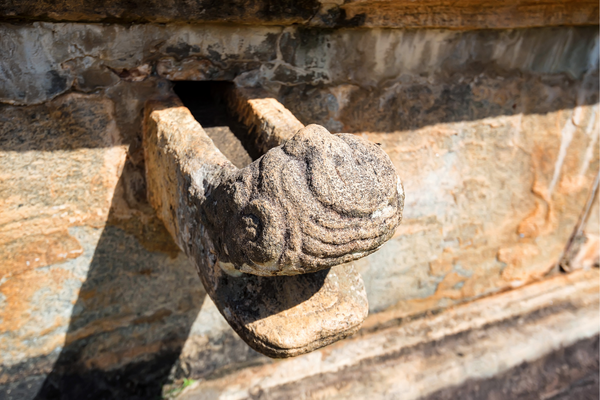Hidden archeological ruins in tranquil Girandurukotte – By Arundathie Abeysinghe

 Lush verdant paddy fields stretching as far as the eye can see…Tree canopies above resembling a storybook setting… Tranquil and serene lake with birds fluttering above enhanced the picturesque surroundings… Village life moving at a slow pace…
Lush verdant paddy fields stretching as far as the eye can see…Tree canopies above resembling a storybook setting… Tranquil and serene lake with birds fluttering above enhanced the picturesque surroundings… Village life moving at a slow pace…
Situated approximately 19 kilometers from *Mahiyangana, Girandurukotte is a small agricultural town in *Badulla District of *Uva Province. Populated in the 1980’s due to the Mahaweli Development scheme, this small town is bustling with activity.
Almost all the land in Girandurukotte has been utilized for rice cultivation, predominantly an outcome of the Mahaweli Development Project that was implemented to develop agriculture in the dry zone of Sri Lanka. Although, the livelihood of the inhabitants of Girandurukotte is dependent on rice, crops such as maize and finger millet are also grown in private gardens, utilizing a process of crop rotation known as *chena.
Situated off the beaten track and rarely visited by local and foreign tourists, there are archaeological ruins located in conserved remains of a small temple complex. Although, it is an archaeological site, the structure is a stupa, yet, there is no description and none could explain its significance. The base of the stupa in the Temple Complex has valuable archeological ruins.
According to legends, the location has been the place where *King Dutugemunu has assembled his armies before the great battle against the invading South Indian ruler *Elara was carried out. The Temple Complex has been constructed on a rocky terrain. Scholars are of the view that King Dutugemunu would have chosen this location to assemble his troops as it would have been easy to lookout for invading enemies from this strategic location.
Scholars are of the view that the Temple Complex is a noteworthy location due to the presence of a panchawasa – a temple comprising five main components: a stupa, a shrine room, a bodhigara (structure of a Bodhi tree), a gathering hall as well as a preaching hall. Archaeologists are of the view that the Complex is one of only two existing panchawasa temples in Sri Lanka and is considered as the best example of a gathering hall, ever discovered.
At the entrance of the Complex, there are ruins of an exquisitely carved standing Buddha Statue and its height is approximately a meter and a half. Currently, most of the carvings on stones and ruins are not visible. At present, there are stones piled up in ruins which would have once been a part of a tall protective wall which stands up to about 10-metres high in certain places.
The base of the stupa in the Temple Complex is constructed on a square platform enclosed by a brick wall. Three brick steps located within a pair of exquisitely carved balustrades (Korawak Gal) represent the mythical *Makara (dragon) at the top and are located on one side to enter the platform. The sides are carved with a lion figure and a pillar exquisitely carved. At the foot of the stairs is a moonstone with a simple carving. There are stone-carved Makara figures and water collected on the platform is drained through the mouths of these figure. In front of an ancient building, there are stone pillars. There are also exquisitely carved muragal (guard stones) in the Complex.
*Ulhitiya Reservoir is also situated in the vicinity of the archeological site. The surface of the reservoir is still with gentle ripples formed by the breeze. The border of *Maduru Oya National Park is adjacent to the Reservoir.
- Badulla District – Situated in lower central hills, Badulla is the capital city of *Uva Province and Badulla District.
- Chena – This is a traditional form of faming in Sri Lanka. In the past, each village had a chena. Vegetables, cereals as well as green leaves are cultivated in a chena.
- Elara – Known as “Ellalan” among Tamils, Elara (235 BC – 161 BC) was a member of the Tamil Chola Dynasty (Chola Empire of Southern India, one of the longest ruling dynasties in world history) also known as “Manu Needhi Cholan”, who upon capturing the throne became king of the Anuradhapura Kingdom (the first kingdom in ancient Sri Lanka and King Pandukabaya 474 BC – 367 BC was the first monarch to rule Sri Lanka from Anuradhapura from 377 BC). Elara is traditionally presented as being a just king even by the “‘Sinhalese'”.
- King Dutugemunu – Also known as “Duttagamini”, Prince Dutugemunu was born to a royal family in southern Sri Lanka. His parents were King Kavantissa and *Princess Vihara Maha Devi. Prince Dutugemunu became King Dutugemunu (164 BC – 140 BC). His brother was Prince Saddha Tissa.
- Maduru Oya National Park – Located to the central-eastern side in the dry zone of Sri Lanka, Maduru Oya National Park was established under the Mahaweli Development Project and is a catchment of the Maduru Oya Reservoir. The Park is well-known for its elephant habitat. There are also several other mammals including leopards (Panthera pardus kotiya), sloth bears (Melursus ursinus inornatus), sambhur (Rusa unicolor unicolor), spotted deer (Axis axis ceylonensis) and barking deer (Muntiacus muntjak), toque macaque (Macaca sinica) and over 100 species of birds including woolly necked stork (Ciconia episcopus), painted stork (Mycteria leucocephala), yellow-fronted barbet (Megalaima flavifrons), Sri Lanka jungle fowl (Gallus lafayettii) and Sri Lanka spur fowl (Galloperdix bicalcarata). The most dominant physical characteristic of this park is the eight kilometers long range of rocky mountain range located towards the southwest of the park. Maduru Oya National Park was designated as a national park on November 9. 1983.
- Mahaweli River – Sri Lanka’s longest river, 335 kilometers in length with a drainage basin of 10,448km2.
- Mahiyangana – A town situated in Badulla District of Uva Province of Sri Lanka.
- Makara – Considered as guardians of gateways and thresholds, they protect throne rooms as well as entryways to temples. Makara is the most commonly recurring creature in Buddhist and Hindu temples iconography. According to Hindu mythology, Makara is a legendary sea-creature. In Hindu astrology, Makara is equivalent to the Zodiac sign Capricorn.
- Princess Vihara Maha Devi – She was the daughter of King Kelanitissa and the Queen consort of King Kawantissa who was known as Queen Viharamahadevi after marriage. Queen Viharamahadevi was the mother of King Dutugemunu and Prince Saddhatissa. According to legends, the innocent Princess sacrificed her life to the sea to stop waves which were flooding inland. But when the boat was drifted to the sea, the sea had become calm and the boat had drifted inland saving the Princess. King Kawantissa had been impressed by her bravery and got married to her.
- Ulhitiya Reservoir – Constructed across Ulhitiya Oya (Oya meaning stream in Sinhala), Ulhitiya Reservoir is a spectacular twin reservoir that brings *Mahaweli River water (through Trans-Basing Canal). It is the leading reservoir for System B and C irrigation networks. Located in *Maduruoya National Park area, this reservoir is mainly utilized for fisheries and irrigation activities whilst the water of the Reservoir is fed into Maduru Oya Reservoir.
- Uva Province – This is the fourth largest province in Sri Lanka bordered by Central, Eastern and Southern provinces.








